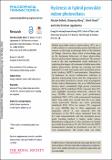Files in this item
Hysteresis in hybrid perovskite indoor photovoltaics
Item metadata
| dc.contributor.author | Bulloch, Alasdair | |
| dc.contributor.author | Wang, Shaoyang | |
| dc.contributor.author | Ghosh, Paheli | |
| dc.contributor.author | Jagadamma, Lethy Krishnan | |
| dc.date.accessioned | 2022-03-16T10:30:02Z | |
| dc.date.available | 2022-03-16T10:30:02Z | |
| dc.date.issued | 2022-04-18 | |
| dc.identifier | 278117060 | |
| dc.identifier | abc05483-e20e-4b57-aad0-7d552134d23c | |
| dc.identifier | 35220768 | |
| dc.identifier | 000761598700013 | |
| dc.identifier | 85125427862 | |
| dc.identifier.citation | Bulloch , A , Wang , S , Ghosh , P & Jagadamma , L K 2022 , ' Hysteresis in hybrid perovskite indoor photovoltaics ' , Philosophical Transactions of the Royal Society A: Mathematical, Physical and Engineering Sciences , vol. 380 , no. 2221 , 20210144 . https://doi.org/10.1098/rsta.2021.0144 | en |
| dc.identifier.issn | 1364-503X | |
| dc.identifier.other | ORCID: /0000-0002-4339-2484/work/109316254 | |
| dc.identifier.other | ORCID: /0000-0001-9870-6842/work/109316521 | |
| dc.identifier.uri | https://hdl.handle.net/10023/25055 | |
| dc.description | L.K.J. acknowledges funding from UKRI-FLF through grant no MR/T022094/1. | en |
| dc.description.abstract | Halide perovskite indoor photovoltaics (PV) are a viable solution to autonomously power the billions of sensors in the huge technology field of the Internet of Things. However, there exists a knowledge gap in the hysteresis behaviour of these photovoltaic devices under indoor lighting conditions. The present work is the first experimental study dedicated to exploring the degree of hysteresis in halide perovskite indoor photovoltaic devices by carrying out both transient J-V scan and steady state maximum power point tracking (MPPT) measurements. Dependence of hysteresis on device architecture, selection of electron transporting layers and the composition of the perovskite photoactive layers were investigated. Under indoor illumination, the p-i-n MAPbI3-based devices show consistently high power conversion efficiency (PCE) (stabilized PCE) of greater than 30% and negligible hysteresis behaviour, whereas the n-i-p MAPbI3 devices show poor performance (stabilized PCE ∼ 15%) with pronounced hysteresis effect. Our study also reveals that the n-i-p triple cation perovskite devices are more promising (stabilized PCE ∼ 25%) for indoor PV compared to n-i-p MAPbI3 due to their suppressed ion migration effects. It was observed that the divergence of the PCE values estimated from the J-V scan measurements, and the maximum power point tracking method is higher under indoor illumination compared to 1 Sun, and hence for halide perovskite-based indoor PV, the PCE from the MPPT measurements should be prioritized over the J-V scan measurements. The results from our study suggest the following approaches for maximizing the steady state PCE from halide perovskite indoor PV: (i) select perovskite active layer composition with suppressed ion migration effects (such as Cs-containing triple cation perovskites) and (ii) for the perovskite composition such as MAPbI3, where the ion migration is very active, p-i-n architecture with organic charge transport layers is beneficial over the n-i-p architecture with conventional metal oxides (such as TiO2, SnO2) as charge transport layers. This article is part of the theme issue 'Developing resilient energy systems'. | |
| dc.format.extent | 19 | |
| dc.format.extent | 1806716 | |
| dc.language.iso | eng | |
| dc.relation.ispartof | Philosophical Transactions of the Royal Society A: Mathematical, Physical and Engineering Sciences | en |
| dc.subject | Triple cation perovskites | en |
| dc.subject | Ion migration | en |
| dc.subject | Maximum power point tracking | en |
| dc.subject | Internet of Things | en |
| dc.subject | CH3NH3PbI3 | en |
| dc.subject | QC Physics | en |
| dc.subject | TK Electrical engineering. Electronics Nuclear engineering | en |
| dc.subject | DAS | en |
| dc.subject | SDG 11 - Sustainable Cities and Communities | en |
| dc.subject | SDG 12 - Responsible Consumption and Production | en |
| dc.subject | SDG 7 - Affordable and Clean Energy | en |
| dc.subject.lcc | QC | en |
| dc.subject.lcc | TK | en |
| dc.title | Hysteresis in hybrid perovskite indoor photovoltaics | en |
| dc.type | Journal article | en |
| dc.contributor.institution | University of St Andrews. School of Physics and Astronomy | en |
| dc.contributor.institution | University of St Andrews. Centre for Energy Ethics | en |
| dc.identifier.doi | 10.1098/rsta.2021.0144 | |
| dc.description.status | Peer reviewed | en |
This item appears in the following Collection(s)
Items in the St Andrews Research Repository are protected by copyright, with all rights reserved, unless otherwise indicated.

